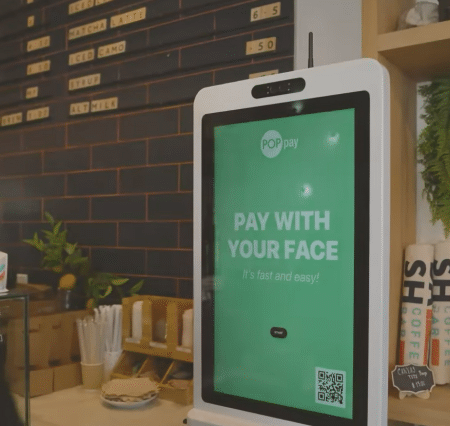Demystifying the relationship between commercial biometrics and privacy
Each day, biometric payment systems and computer vision-based shopping experiences are popping up at more establishments throughout the world. But some consumers are hesitant about being watched so closely, arguing retail systems can coerce consumers into handing over personal data with limited other options.
Here’s what biometrics providers have to say about the steps they’re taking to preserve trust and privacy for consumers.
Consumer biometrics for face authentication, not surveillance
It’s been a busy year for Wicket, a biometrics company that ties facial authentication to ticketing. NFL fans in Nashville can enter stadiums faster with a face scan, while Cleveland Browns fans can additionally expedite their beer purchasing experience at concessions through age verification using the company’s technology.
Wicket’s system is installed as an optional express line, and fans can still access all the stadium has to offer the old-fashioned way if they choose.
The software doesn’t actually store the facial photo itself from attendees. Instead, when a user makes an account, it immediately converts the data into a hash file, which uses a hash function to produce a unique output that is impossible to reverse.
“When somebody walks up to one of our units for ticketing or payments and we match your face, we’re not actually storing pictures of faces on those devices. We’re storing the mathematical hash files and matching those with what we capture,” explains Jeff Boehm, Wicket CMO, in an interview.
Customers can opt to have their stored data deleted from Wicket at any time.
While some uses include access control to restrict certain areas for employees only, Boehm emphasizes that, for fans, the tech is not used “to keep people out” for security or surveillance reasons. “Our goal is to let the right people in, validating that whomever actually has tickets to the event today should be allowed in.”
One single fan can have multiple tickets linked to their biometric authentication, which cuts down on the data that the system would need to collect. A parent can authenticate for themselves, their partner, and their children by linking 4 tickets to their account. This also creates a clear avenue for kids to get in through the system without ever providing their biometrics.
When it comes to data security and privacy, “it’s really important for us to be very transparent because we need the teams and the fans to trust us,” Boehm says. “As with any new technology, people are unsure at first. You need to build that trust so that people see the value and aren’t worried about the potential downsides.”
Computer vision without biometrics in Amazon’s cashierless retail
Amazon‘s Just Walk Out cashierless checkout system promises to deliver an innovative retail experience for customers and businesses alike, with over 100 third-party retailers using Just Walk Out in the U.S., UK, Australia, and Canada as of today, and new locations launching each month.
The system tracks shoppers using a combination of cameras and weight-sensing shelves. Shoppers submit a payment method upon entry, collect their desired items, and “just walk out” without needing to go to a cashier. The tech has been implemented in stadiums, campuses, and convenience stores, to name a few locations.
In an email to Biometric Update, an Amazon spokesperson claimed that Just Walk Out does not collect biometrics but instead “uses a combination of sophisticated AI technologies like computer vision, sensor fusion, and deep learning to distinguish shoppers from one another, link a customer to their method of payment, and determine ‘who took what.’” Amazon did not directly define the term “biometrics” when invited to do so.
Shoppers are assigned a temporary numeric code that connects an individual to their payment method and acts as a unique “digital signature” for a single store visit. Individuals can choose to use the Amazon One palm-scanning biometric payment method, which identifies shoppers by capturing palm and vein images, but this operates independently from the Just Walk Out tech.
While it does not collect biometrics, “in every image” the system collects, “we have a number of pixels that belong to a person,” said Gérard Medioni, vice president at Amazon in an explanatory post. It’s able to update the signature if a shopper takes off their jacket while in store and can differentiate between shoppers as well as track groups of shoppers linked to a single card.
Even with these privacy considerations in mind, Amazon is still facing a number of lawsuits for allegedly collecting biometrics and violating data privacy.
One lawsuit claims that Amazon violated the Illinois Biometric Information Privacy Act by collecting shoppers’ biometric data to train surveillance technology without first obtaining proper consent. Moreover, a class-action suit in New York City claimed Amazon did not post signage alerting customers that they were being monitored until months after the Biometric Identifier Information Law for the city went into effect.
The suits demonstrate consumers’ skepticism that they can trust retailers enough to track them so closely without abusing the data they use.
Consumer insights through computer vision
More data is being collected from consumers than ever before, and while online retailers once had the unique advantage of personalizing recommendations based on data-tracking, retailers are finding more ways to tailor in-person marketing, as well.
Amazon suggests that third-party retailers who use Just Walk Out can benefit from store data analytics in a number of ways, including promotional strategizing, streamlining operations costs, and gaining insight “across the store and at the shelf … about how products are considered and purchased,” according to its product page.
Analytic insights come from “aggregated and anonymized traffic patterns and performance across the store and by shelf, fixture, and product category,” allowing retailers to identify patterns in what items get picked up first, which ones are frequently purchased together, and what consumers place back on the shelf.
This can help retailers strategize product placement, eliminate products with the lowest conversion rates, and identify high-traffic times when staffing is most needed.
In a similar vein, Vsblty‘s digital cooler screen panels can be set to display what’s in the cooler through a transparent mode or be used to display messages to consumers. It collects data on how long and where the consumer is looking on the screen as well as demographic information such as age and gender to create marketing insights for retailers, all while preserving anonymity.
Numerous consumers around the world had their first experience of retail biometrics in 2023. Even more will have their first experience of the technology in 2024. How comfortable they feel with the experience will depend largely on how well they feel their privacy is being protected.







